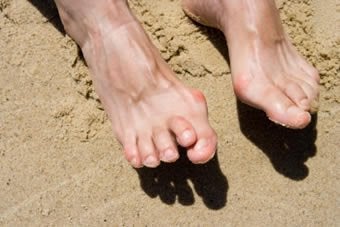 Hammertoes occur when there is an imbalance in the muscles and ligaments that would normally hold the toe straight. This results in the toe bending over time and ultimately becoming deformed. Hammertoe typically affects the second, third, fourth, and fifth toes, not the big toe. If discovered and managed early, treatments can be non-invasive and the hammertoes may be able to be corrected without surgery. Although hammertoe may be a congenital disorder in some, usually the cause is either a previous toe injury or wearing ill-fitting shoes. The toes can become cramped and start to bend gradually if there is not enough space for them. This is especially the case for people with longer than average toes. If you notice your toes are bent up in a cramped position, seek medical attention. Catching this early is crucial.
Hammertoes occur when there is an imbalance in the muscles and ligaments that would normally hold the toe straight. This results in the toe bending over time and ultimately becoming deformed. Hammertoe typically affects the second, third, fourth, and fifth toes, not the big toe. If discovered and managed early, treatments can be non-invasive and the hammertoes may be able to be corrected without surgery. Although hammertoe may be a congenital disorder in some, usually the cause is either a previous toe injury or wearing ill-fitting shoes. The toes can become cramped and start to bend gradually if there is not enough space for them. This is especially the case for people with longer than average toes. If you notice your toes are bent up in a cramped position, seek medical attention. Catching this early is crucial.
Hammertoes can be a painful condition to live with. For more information, contact Dr. Jon M. Sherman of Kentlands Foot & Ankle Center . Our doctor will treat your foot and ankle needs.
Hammertoe
Hammertoe is a foot deformity that affects the joints of the second, third, fourth, or fifth toes of your feet. It is a painful foot condition in which these toes curl and arch up, which can often lead to pain when wearing footwear.
Symptoms
- Pain in the affected toes
- Development of corns or calluses due to friction
- Inflammation
- Redness
- Contracture of the toes
Causes
- Genetics – people who are genetically predisposed to hammertoe are often more susceptible
- Arthritis – because arthritis affects the joints in your toes, further deformities stemming from arthritis can occur
- Trauma – direct trauma to the toes could potentially lead to hammertoe
- Ill-fitting shoes – undue pressure on the front of the toes from ill-fitting shoes can potentially lead to the development of hammertoe
Treatment
- Orthotics – custom made inserts can be used to help relieve pressure placed on the toes and therefore relieve some of the pain associated with it
- Medications – oral medications such as anti-inflammatories or NSAIDs could be used to treat the pain and inflammation hammertoes causes. Injections of corticosteroids are also sometimes used
- Surgery – in more severe cases where the hammertoes have become more rigid, foot surgery is a potential option
If you have any questions please feel free to contact our office located in Gaithersburg, MD . We offer the newest diagnostic and treatment technologies for all your foot and ankle needs.


